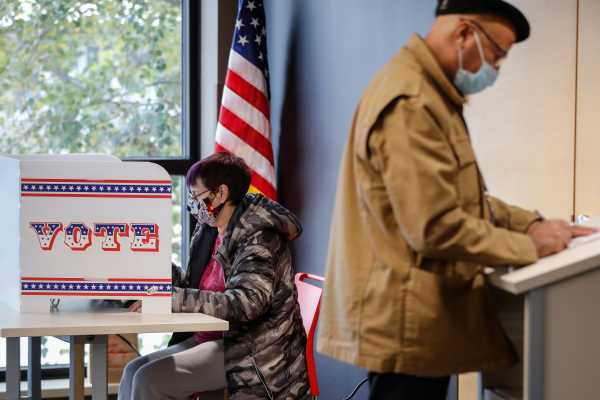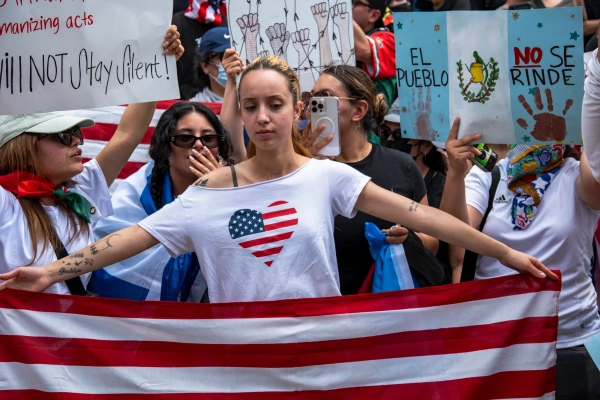
Everybody should have a plan to vote. And if you’ve considered leaving your house to go to the polls, you should know: Voting in person is relatively safe even amid the Covid-19 pandemic.
In fact, according to public health experts, it is roughly as risky as going to the grocery store, something Americans still do regularly.
The coronavirus has presented the United States with a daunting logistical challenge as the country attempts to conduct a presidential election in the middle of an infectious disease outbreak. Not only are states having to figure out how to distribute and collect an unprecedented number of mail-in ballots and create safe places for people to vote in person, Americans are facing a stressful question: Is it safe to go vote?
The answer, according to three public health experts I consulted, is yes — with some conditions.
“I think it’s relatively low risk, probably around going to a grocery store,” Amesh Adalja, a senior scholar at the Johns Hopkins Center for Health Security, told me. “In general, it’s an activity that’s amenable to social distancing. … In general, I don’t think it’s a major risk.”
Kumi Smith, an epidemiology professor at the University of Minnesota, told me the same thing. “I consider voting to be relatively safe,” adding: “but as with all activities, people should be making risk/benefit calculations for themselves.”
To Smith’s point, this is an individual decision. Some people might prefer to be risk averse and opt for voting by mail. One way to split the difference is to vote early when the crowds are usually smaller.
But the point is, people have options and, if they choose to vote in person for whatever reason, they should be able to do it safely.
“Bottom line? If voting in person is important to you or is your only option, you can do so relatively safely,” Jen Kates, director of global health and HIV policy at the Kaiser Family Foundation, said.
Here are a few things to keep in mind.
Take simple precautions to protect yourself and others
Voters might want to start by taking stock of the Covid-19 safety protocols their polling place is following, experts said. That could help them in making a decision about voting early versus voting on Election Day.
“Voting locations should implement rules about masking and social distancing,” Smith said. “Even more ideally, they will have other structural measures in place like physical barriers, one-way traffic lanes, or provision of hand sanitizer.”
Waiting in line outside would also be ideal, according to Kates, and some polling locations provide updates on wait times that people could use to try to avoid the busiest times of the day.
When people actually go to vote, they should take all the same precautions that they should take anywhere they go: Wear a mask. Keep 6 feet of distance from other people. Wash your hands or use hand sanitizer liberally.
“With these conditions, it is relatively low risk,” Kates said. Adalja agreed: “If you go to a polling place, as long as you’re wearing a face covering or washing your hands, I think this is a manageable risk.”
It’s a good idea, though, to be prepared for the unexpected.
“It’s also always good to have a plan in place in case the less expected occurs, like finding yourself standing in line next to someone chatty who won’t respect your distance,” Smith said. “Or longer wait times and possible exposure to the elements.”
Voting safely should be doable. We’ve already done it.
The other good news is we aren’t just guessing about whether voting is relatively safe. Elections have been held during the Covid-19 pandemic and there isn’t much evidence that they’ve led to major new clusters of cases.
“I haven’t heard of any major outbreaks that have been linked to voting,” Adalja said.
The Wisconsin primary election in April was closely watched for possible transmission after the Republican-controlled state supreme court blocked a plan by Democratic Gov. Tony Evers to postpone the election for two months.
Several studies were conducted trying to assess any increased Covid-19 spread after the primary election. Most have found no effect from the election (though there was at least one exception), and the most authoritative study, from researchers at the CDC and the city of Milwaukee’s health department, concluded that there was “no clear increase” in coronavirus cases after the primary.
Importantly, that report credited the mitigation strategies taken by polling locations for their apparent success in containing Covid-19.
This is not to say there is no risk at all: There were a few dozen confirmed cases linked to people who voted in Wisconsin or worked at a voting location. But all risk is relative in the time of coronavirus, and voting can be made more safe with some simple harm reduction.
Make your own risk assessment about voting in person
How to vote is a decision for each person to make. Every state has its own election laws, so check out resources like Vote.org to make sure you know the rules in your state and your voting options.
Then, it’s worth taking into consideration your own risk tolerance. No matter what, voting can be done safely, but some options are safer than others.
For the people who are more vulnerable to Covid-19 or who are often in contact with more at-risk populations, they might want to minimize their risk of exposure. Other people might have a higher risk tolerance. (As an example: Adalja told me that he himself had a pretty high tolerance for risk and he would have no hesitation about voting in person.)
Voting by mail is probably the safest option, from a public health perspective, and millions of people have already done so this year. But whether it’s simply too late for you to vote by mail or you prefer to vote in person to eliminate the possibility of any mistakes in your ballot being processed, you can vote safely in person.
Here is another way to think about risk: Adalja said that he was much more worried about Covid-19 spreading because people are holding gatherings indoors — Halloween parties, for example — than he was worried about transmission when people vote.
The coronavirus doesn’t spread from fleeting contact. The rule is you need to be within 6 feet of a person for more than 15 minutes to be considered at risk of exposure.
“Most of that risk can be removed pretty easily, with a little bit of foresight,” Adalja said.
As Vox’s Ezra Klein wrote this week, “It’s the most important election in our lifetime, and it always will be.” Covid-19 has been an unexpected and unwelcome wrinkle in the 2020 race. But it shouldn’t stop Americans from participating in the democratic process.
Just be smart to stay safe.
This story appears in VoxCare, a newsletter from Vox on the latest twists and turns in America’s health care debate. Sign up to get VoxCare in your inbox along with more health care stats and news.
Help keep Vox free for all
Millions turn to Vox each month to understand what’s happening in the news, from the coronavirus crisis to a racial reckoning to what is, quite possibly, the most consequential presidential election of our lifetimes. Our mission has never been more vital than it is in this moment: to empower you through understanding. But our distinctive brand of explanatory journalism takes resources. Even when the economy and the news advertising market recovers, your support will be a critical part of sustaining our resource-intensive work. If you have already contributed, thank you. If you haven’t, please consider helping everyone make sense of an increasingly chaotic world: Contribute today from as little as $3.
Sourse: vox.com






